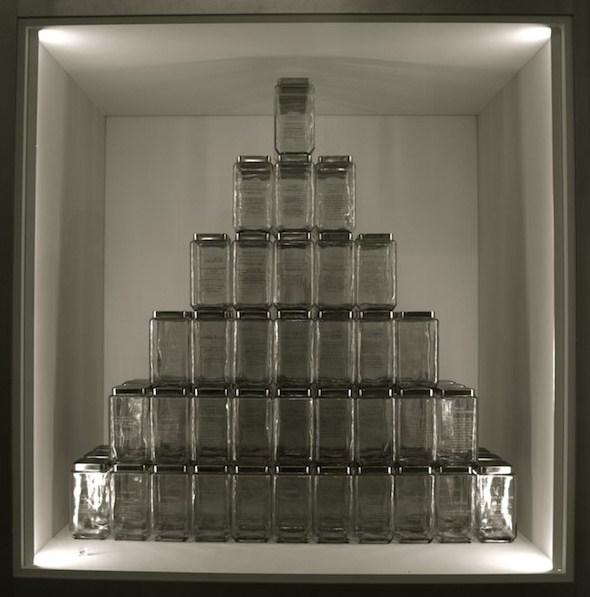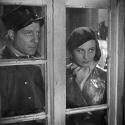On the tip-off of an art-loving West Country amigo, Miss April and I took a day out of our Easter hols to visit the recently re-opened Royal Albert Memorial Museum & Art Gallery, in Exeter.
We’d missed the exhibition of French and British impressionism (Monet, Renoir, Pissarro, and some Englishmen), so we took the opportunity to wander aimlessly round the satisfyingly manageable building and reacquaint ourselves with that childlike enthusiasm for the Wonder House (as the natives call the Devon museum). Despite its rooms full of Egyptologica, taxidermised birds, Grand Tour bling, Congolese artefacts, “camera-less photography”, and cases devoted to local collectors (of fossils, stamps, irons, etc.), the RAMM only displays something like 0.1% of its holdings. But in the central gallery they’d erected a kind of Best of RAMM, an “if we could show you everything…” cabinet of curiosities.
My enthusiasm for these unashamedly eclectic (not to say “random”) collections of one-man’s-junk – sparked, I’m fairly certain, by the wunderkammer opening of Bruce Chatwin’s In Patagonia – was additionally tickled as, following the wall from the prehistoric top-left to the present bottom-right, I arrived at the Nicky Hirst commission, Recollection. This is a series of engraved glass jars containing (no, I don’t think so, either) different smells ostensibly suggested by RAMM’s visitors: hot tarmac, baking bread, old money, and some significantly more whimsical than that ("Damp Wool: 1947 youth-hostelling with mates"). Hirst’s piece – and its punning title – walks the line between artwork and archaeology, and encapsulates (metaphor ends) the museum’s own work of collection, from the hunting and gathering of North Devon’s earliest inhabitants to the work now being done by its artists. Nicely done. RAMM’s tagline – “Home to a million thoughts” – is also not a bad effort, as these things go.
---
In a similar vein, but not quite, was the Broomhill Sculpture Park, currently starring, among its many and various pieces, exhibitions by Ronald A Westerhuis and Carol Peace. These two sculptors couldn’t be much more different, Peace’s pieces focusing solely on the human body – in its recognisable, traditional shape, albeit with (necessarily?) platey feet – while Westerhuis produces abstract items that are terribly shiny and attractive but frankly invite you to raise an eyebrow somewhere between reading the titles and looking at the price-tags. (Where you see a “POR” sticker, assume the King’s Road rule applies: if you have to ask, you ain’t buyin’.)
Elsewhere, my fair companion backed off from The Woman With Three Holes until it was calmly pointed out that the piece in question, an abstract human form, was not a naughty Alan Bennett story, but actually Woman [no comma] with three holes. Caveat lector. She was rather more taken with Greta Berlin’s massive (and self-evident) Red Shoe.
For my part, I enjoyed a grove of colourfully painted trunks (artist forgotten), some stone blocks transplanted across stream and into tree (Jake Rusby, I think), and a piece called Antonia’s Dress, a metal vortex made out of old road signs. Also Mike Roles’ rather brutal Welcome to the Third Millennium, a series of variously decaying metal people (+ laundry) spray-painting walls, lobbing grenades, blowing each other up, and sucking each other off.
It is an abiding mercy that, unless you go looking for it, you are, for the most part, spared the pseudo waffle of explanatory placards. What doesn’t work quite as well is the mish-mash of styles and their shared context (however ironical) within the Broomhill gardens. Rusting copper and painted ironwork looks fine and dandy in a contoured English woodland; gaudy fibreglass, not so much.
---
On off days (or, weather-wise, on/off days), in between “strolling” along wind-blasted cliffs, playing the 2p slots, dropping in at Dartington Crystal (a most unexpected history of Swedes and wife-swapping in North Devon!), following up on the wondrous and horrendous on Twitter, and resisting the imprecations to watch an animal pull modest stunts on Britain’s (Dogs Have) Got Talent,* I have been reading a new book on The Doors.
Notwithstanding a live [sic] tour a couple of years ago, The Doors – both as people and as an ethos – have not aged well (witness a not particularly good documentary on LA Woman the other night). It’s hard enough for those of us born later to understand how legitimately revolutionary the Sixties and Seventies were, and repeated exposure to Jim Morrison’s questionable poetry (sorry, Jim!) or Ray Manzarek’s dude-lingo rock-n-roll memoirs could easily put you off more than just the band. Certainly, there’s no need for another volume on their tragically short-lived antics.
So Greil Marcus – the Oliver Stone of post-war “counter-culture” music criticism – has done all that remained to be done, and in The Doors: a lifetime of listening to five mean years has written a song-by-song selective exploration of what it was like listening to their records and attending their gigs.
It’s loving, and erudite, and certainly educational: for Doors fans everywhere, this is essential reading. But Marcus is also a man of his time, and deeply prone to flights of Sixties-type free-styling (who else would reference Jenny Diski in a book about The Doors?), combined with an element of musical prissiness I associate more with jazz liner-notes. Better, perhaps, for those with a Greatest Hits album gathering dust somewhere, simply to follow Marcus’s example, fetch it down, and have another listen for themselves.
---
* For the record, we also paid a visit to the Gnome Reserve. I will not speak of this.















Add comment